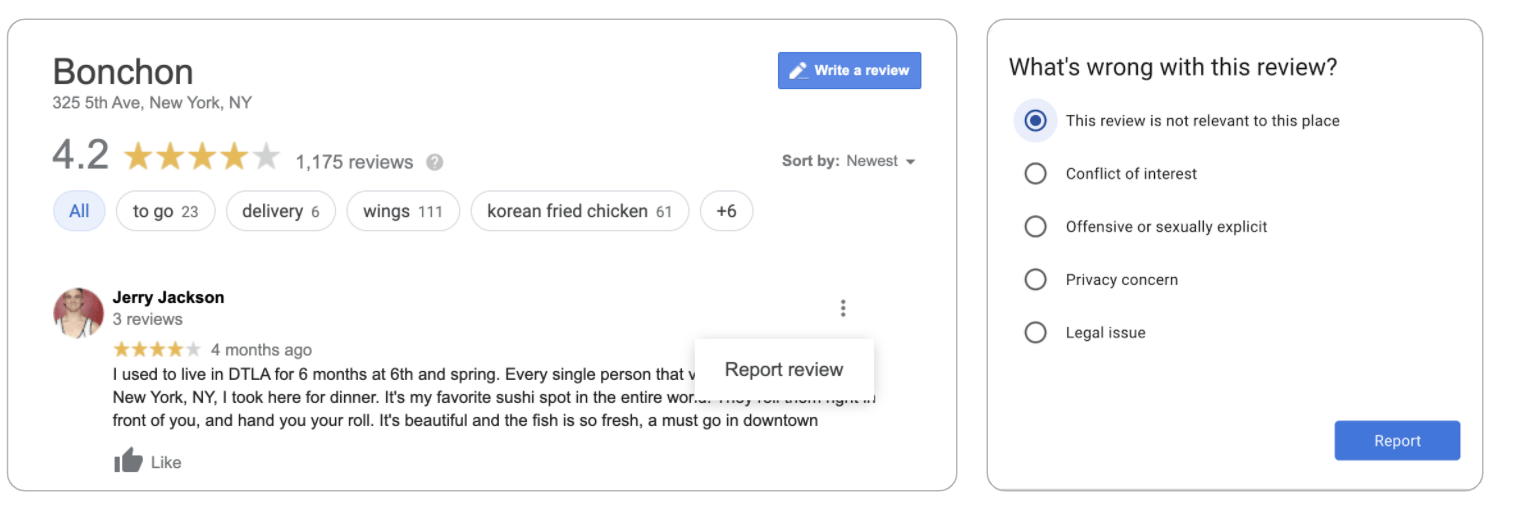
How to Respond to Negative Reviews [Templates Included]
In today’s consumer market, negative reviews are a fact of life. Most of the time, these reviewers have good intentions. The most common motivations for leaving negative reviews include:
- Helping others make better purchase decisions
- Helping the company improve its products, services, or policies
- Getting the company to acknowledge personal concerns
Reviewers rarely want to take you down – they just want to know that you care about the customer experience. That is why addressing negative reviews publicly and avoiding practices like review gating is actually good for your business.
And the reviewer isn’t the only one who wants this reassurance.
A lot of customers read businesses’ responses to reviews before making a purchase decision. The better you understand how to respond to negative reviews, the more you can use these moments to your advantage – strengthening customer ties and showcasing your professionalism. You might even get a customer to change their review.
So, You Received a Negative Review. Now What?
Seeing a negative review can easily send a business owner or marketer into reaction mode. Being in reaction mode makes you defensive, which makes you less likely to respond constructively.
To break this cycle, have a game plan for responding to negative reviews. Over the years, the Uberall team has assisted customers in developing responses to both positive and negative reviews. Based on our extensive experience we’ve pulled together this step-by-step strategy as your guide.
Responding to Negative Reviews Step #1: Read to Understand
Avoid the urge to push the panic button. Take a pause and read the review carefully. Remember that if this reviewer has a legitimate concern, their feedback can be an opportunity to turn things around and potentially win back a customer that might have otherwise churned. Sometimes a negative review can come from a small oversight.
For example, you might have recently changed your hours of operation, but forgot to update your listings to reflect more limited seasonal hours - and a customer who was eager to make a visit showed up to a closed store. By responding to the customer about the miscommunication and following up with them directly offline, you can potentially earn a loyal customer for life.
Responding to Negative Reviews Step #2: Evaluate the Review
Before you think about how to respond to negative reviews, ask yourself if the reviewer has a valid point and uses a constructive tone. If so, move on to step three.
Otherwise, look for signs that it might violate review site policies. Sites like Google, Yelp, and Facebook forbid certain types of content including:
- Offensive language
- Harassment and threats
- Former employees retaliating with negative reviews
- Potential employees who were never hired
- Conflicts of interest (e.g., reviews of a competitor)
- Reviews of the Wrong Business
- Violations of privacy
- Spam and solicitation
In the below example, the restaurant reviewed does not offer sushi, so it is clear the reviewer wrote this comment for the wrong business. The review was flagged to Google for removal.

If the review violates standards, you can request its removal through the platform. From our experience, Yelp and Facebook are the most responsive to removing flagged reviews, while Google reviews have a significantly lower chance of being removed. We recommend having three to five users report each review for the best chance of your review being removed.
Here’s how to remove negative reviews from Google and other popular review sites:
- Google: Flag the review through your Google My Business account
- Facebook: Go to the review and select Find support or report recommendation
- Yelp: Log into your account, navigate to the review, and click to report
- TripAdvisor: Go to the review and click on the grey flag to report it.
Finally, if the review touches on a legal issue, don’t respond online at all. Bring the review to your legal team and have them suggest your next step.
Responding to Negative Reviews Step #3: Decide on a Response Strategy
If the review is legitimate and not spam, it’s time to craft an empathetic and proactive response. In general, you’ll want to:
- Acknowledge the issue and apologize if needed
- Communicate your commitment to making things right
- Respond to any positive feedback as well
- Provide an email or phone number for the customer to follow up offline
To get you started, here are a few negative review response examples. Use them as templates and customize the content to match your brand tone.
If the cause for the complaint is clear and you can fix it, acknowledge the issue, and start the wheels moving toward a solution:
{Username}, We're sorry to hear our {service/product} at {business} did not live up to your expectations. We want to follow up with you directly so we can figure out what happened, and how we can make it up to you on a future visit. . When you have a moment, please email us at xxx@xxx.com and we’ll reach out to your immediately.
If the cause for complaint is clear but you can’t fix it, touch on what you’ll do differently in the future:
Thank you for taking the time to share your concerns with us. Though it’s never easy hearing we’ve disappointed one of our customers, we appreciate you taking the time to share where we fell short, so we can improve going forward. Should you decide to give us another chance, and we sincerely hope you do, please reach out to us at {email address} so we can give you an extra special experience.
If there isn’t enough detail in the review, or if it’s just a star rating with no comment, consider following up with a response that solicits more information:
{Username}, oh no! Great customer service is something we always strive for at {company name}. We’d like to get more details so we can make your next visit a better one – please send your contact info and reference this review at xxx@xxx.com.
If the topic is sensitive, like a billing problem or a he said/she said scenario, take things offline:
We’re so sorry to hear that this happened to you. We’d like to know more so we can make things right. Please send us an email at xxx@xxx.com so we can follow up with you directly.
Get More Positive Reviews
We hear from many customers that the online reviews for their business don’t reflect the overwhelmingly positive feedback that they receive directly. That’s normal, and here’s why.
In general, dissatisfied customers tell at least nine people about their experience, if not more. That often includes leaving a bad review. On the other hand, only one in 10 happy customers leave positive reviews.
The way the math works out, it takes four five-star reviews to make up for every one-star review. That means it will take 40 positive customer experiences to make up for every negative review – unless you actively prompt your happy customers to submit reviews. By burying bad reviews with good ones, customers are less likely to come across negative reviews. To get positive reviews, it’s important for brands to suggest that customers leave reviews when they know they’ve had a good experience.
One fun way to do this is by running a contest across all your locations. Challenge your employees to ask happy customers to give you a review, and offer a team prize or an employee raffle for the location that generates the most five-star reviews.
Respond to All Reviews, Not Just the Negative Ones
Knowing how to respond to negative reviews is important but highlighting your positive reviews can help as well.
While the algorithm that Google uses to determine the order of relevant reviews displayed in search results is not public, it does appear that a business's reply to a review can boost relevance. In other words, if you only respond to negative reviews those reviews will likely appear ahead of more recent positive reviews.
To keep negative reviews from dominating your review pages, simply reply to all reviews. Not only will it help ensure more positive reviews show up on top, but it will also reflect positively on your business, showing potential customers that you care about customer experience.
The Takeaway
By learning how to respond to negative reviews, your business can make better connections with customers and improve your reputation online. Responding to your past customers’ experiences can influence future customer visits and also help your business perform better in search rankings.
And remember, positive reviews matter too. Encourage happy customers to rate you online and thank those who do.
It's a lot to manage, but Uberall can make it much easier. With personalized and localized response templates, automated review response, and the ability to monitor reviews across all your locations, Uberall review tool lets you track complaints all the way to resolution.
Reply faster and improve the quality of your responses with our review response templates
